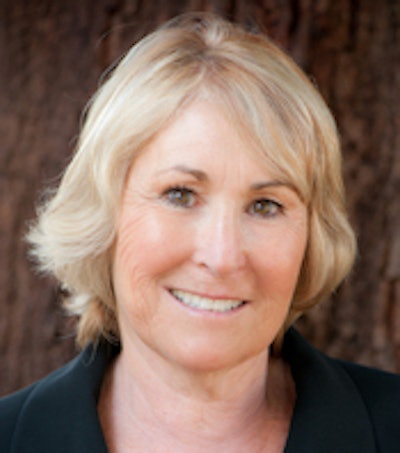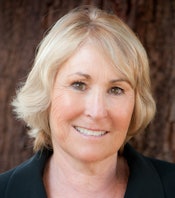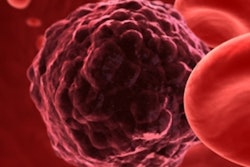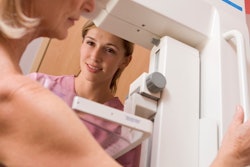
How can your breast center set itself apart in an increasingly competitive environment, one that's turning from a volume-based system into a value-based one that rewards better patient care outcomes? One way is to offer women high-risk assessment resources, according to a presentation given at the recent AHRA 2015 meeting in Las Vegas.
Across the board, breast imagers, technologists, and nurse navigators are all working toward the same goal: to detect breast cancer early, said Terry Bucknall, director of women's imaging services at Henry Mayo Newhall Hospital's Sheila R. Veloz Breast Center in Valencia, CA. And patients appreciate the extra effort.
"As women's health advocates, we've got to be able to identify women who are at high risk," she said. "Not only will you save lives, you'll have loyal patients."
A better breast center
The statistics make it clear why creating a high-risk assessment program is a good idea, Bucknall said. For women with BRCA1 or BRCA2 mutations, the risk of breast cancer up to age 50 is 51% and to age 70 is 87%; also, the risk of ovarian cancer up to age 70 is 44%. In contrast, women in the general population up to age 70 have dramatically lower risk percentages across breast, ovarian, and uterine cancer.
| Breast cancer risk, normal vs. high-risk women | |||||
| Cancer type | General population (to age 70) | Women with hereditary risk factors (to age 70) | |||
| Breast | 7.3% | 87% | |||
| Ovarian | 0.7% | 44% | |||
| Uterine | 1.6% | 71% | |||
Combine these high percentages with the fact that a significant number of patients meet criteria for multiple syndromes that can increase risk, and you've got a perfect storm, Bucknall said. At least one in 10 patients with Hereditary Breast and Ovarian Cancer Syndrome (HBOC) meet criteria for Lynch syndrome (a disorder that in women increases the risk of ovarian or uterine cancer), and at least three in 10 Lynch patients meet criteria for HBOC.
 Terry Bucknall from the Sheila R. Veloz Breast Center.
Terry Bucknall from the Sheila R. Veloz Breast Center."Having a too narrow breast or reproductive cancer assessment strategy can lead to a false sense of security for your patients -- and even mismanagement of disease," she said.
Another reason to offer resources for those at high risk is that doing so complies with accreditation standards set by the Commission on Cancer (CoC) and the National Accreditation Program for Breast Centers (NAPBC).
"Both of these entities require that a breast center have both pre- and postgenetic counseling resources in place, either referred or onsite," Bucknall said.
Patients need risk-prevention assessment and genetic testing resources, and they are grateful when these services are available at the same center where they get their mammography exam, according to Bucknall. But it may be challenging to find experts who can support your imaging center. Qualified genetic counselors can be found at the American Board of Genetic Counseling and the American College of Medical Genetics, in addition to contacting genetic clinical nurses, advanced practice nurses in genetics, advanced practice oncology nurses, or physicians with experience in cancer genetics. Online resources and telephone services are also available, she said.
But patient education is just one facet of making your center a resource for high-risk women. Another crucial component is securing support from the imaging team and educating technologists and nurse navigators.
"It's up to you to identify patients who could use risk assessment counseling, and to identify appropriate genetic counseling professionals for referral," she said. "Then, teaching staff to identify high-risk 'red flags' is important, as is having staff meetings that include genetic counselors."
How do we get there?
At Sheila R. Veloz, Bucknall's team tried to implement a protocol where technologists would input a woman's family history into the facility's reporting system, adding risk model thresholds to reports. But this wasn't immediately successful.
"Our technologists found it difficult to fix this patient information in the system," Bucknall said. "So we developed a paper assessment tool."
The group continued its ongoing efforts to educate technologists and to meet with referring providers, according to Bucknall. One key to the program's success was getting a medical oncologist to agree to counsel women with BRCA mutations.
"You have to navigate any 'oncopolitics,' " she said. "Some referring providers are already offering BRCA testing and may feel that you're stepping on their toes. We found that nurse practitioners and physician assistants often had a better understanding of why offering high-risk resources was important. And we also found that meeting with obstetricians and gynecologists helped -- we could explain that our services save them time and protect them from liability issues."
Bucknall outlined her facility's protocol, which starts with a cancer risk assessment form given to the patient when she checks in. Once the patient has turned in the form to the receptionist, it is reviewed by the mammography technologist; if the patient falls in the high-risk category, she meets with the technologist, who can refer her to the genetic counselor. If she agrees to meet with the counselor, an appointment is made and a letter is sent to the patient's referring doctor. If she doesn't, she is given information on hereditary cancer -- and a letter is sent to her referring physician anyway.
"It's not necessary to make things too complicated," Bucknall said. "We say something like, 'In reviewing your family history of cancer, I see some of the flags that we look for that trigger follow-up. There is a test available to help us determine if the cancer in your family is hereditary.' "
Patients have many questions, she said, including whether getting tested will result in insurance discrimination or increased premiums. Reassure patients that there are federal and state laws that protect them from discrimination based on test results, and that having a genetic propensity for breast or ovarian cancer is not considered a pre-existing condition.
Once the woman agrees to testing and undergoes it, if she has a 20% or higher lifetime risk, she meets with an oncologist for genetic counseling or her referring physician makes further surveillance recommendations -- perhaps for an annual MRI, which your center can provide.
"Differentiate yourself from the other breast clinics and imaging centers out there by offering high-risk assessment services," Bucknall said. "The truth is that patients will respect and appreciate your services more."




















